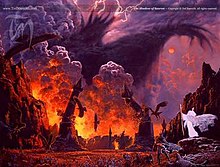Eucatastrophe

Aeucatastropheis a sudden turn of events in a story which ensures that theprotagonistdoes not meet some terrible, impending, and very plausible and probable doom.[1]The writerJ. R. R. Tolkiencoined the word by affi xing the Greek prefixeu,meaninggood,tocatastrophe,the word traditionally used in classically inspired literary criticism to refer to the "unravelling" or conclusion of a drama's plot. For Tolkien, the term appears to have had a thematic meaning that went beyond its literal etymological meaning in terms of form.[2]In his definition as outlined in his 1947 essay "On Fairy-Stories",[3]eucatastrophe is a fundamental part of his conception ofmythopoeia.Though Tolkien's interest is in myth, it is connected to thegospel;Tolkien calls theIncarnation of Christthe eucatastrophe of "humanhistory"and theResurrectionthe eucatastrophe of the Incarnation.[4]The explosion of the Death Star inStar Wars,or the kiss that savesSnow White,have been characterized as eucatastrophes.Longtermistssuch as Owen Cotton-Barratt andToby Ordhave adopted the word to refer to any hypothetical future transition that would provide "existential hope" of not only avertinghuman extinction,but also hope of an "efflorescence" of future abundance.[5]
Eucatastrophe in fiction has been labelled by some as a form ofdeus ex machina,due to both sharing an impossible problem being suddenly resolved.[6][7]However, differences between the two have been noted, such as eucatastrophe's inherent connection to an optimistic view on the unfolding of events in the narrative of the world.[8]In Tolkien's view, eucatastrophe can occur without the use of adeus ex machina.[9]
Eucatastrophe could be held in apposition to dyscatastrophe, another word that Tolkien also used to refer to the sudden turn from which there is no upward movement or hope.
Examples in Tolkien's work[edit]

The best-known and most fully realized eucatastrophe in Tolkien's work occurs in the climax ofThe Lord of the Rings.Though victory seems assured forSauron,theOne Ringis permanently destroyed as a result ofGollum's waylaying of Frodo atMount Doom.[10]Frodo essentially fails his impossible quest at its very end, claiming the Ring for himself – however, at this moment, Gollum suddenly appears, steals the ring, and in his ecstatic gloating falls into the fire. If not for Frodo's previous mercy in sparing Gollum's life (a great risk owing to Gollum's obvious treachery, met with bitter protest by Sam), and if not for the Ring's own corruptive influence on Gollum, Sauron would surely have reclaimed it. Thus, Evil is inadvertently and unforeseeably defeated through a small act of kindness and through its own corruptive machinations.
Another example of eucatastrophe is the recurring role of theeaglesas unexpected rescuers throughout Tolkien's writing. While their role has been described as that of adeus ex machina,[11]Tolkien described Bilbo's "eucatastrophic emotion" at the eagles' appearance inThe Hobbitas one of the key moments of the book.[12]
See also[edit]
References[edit]
Inline citations[edit]
- ^Mazur 2011,p. 174
- ^Greekeu= "good",kata= "down",strephein= "to turn or rotate"
- ^Tolkien 1990,pp. 109–161
- ^Tolkien 1990,p. 156
- ^Fisher, Richard (2022)."Eucatastrophe: Tolkien's word for the" anti-doomsday "".bbc.Retrieved9 November2022.
- ^Westfahl, Gary (2005).The Greenwood Encyclopedia of Science Fiction and Fantasy: Themes, Works, and Wonders.Vol. 1.Greenwood Publishing Group.p. 195.ISBN978-0-313-32951-7.
- ^Hart, Trevor (2013).Between the Image and the Word.Ashgate Publishing, Ltd.ISBN978-1-4724-1370-3.Retrieved7 September2014.
- ^Mazur 2011,p. 175
- ^Magill, Frank (1983).Survey of modern fantasy literature(First ed.). Salem Press. p. 2065.ISBN978-0893564506.Retrieved8 September2014.
- ^Solopova, Elizabeth(2009).Languages, Myths and History: An Introduction to the Linguistic and Literary Background of J. R. R. Tolkien's Fiction.New York City:North Landing Books.p. 29.ISBN978-0-9816607-1-4.
- ^"Top 10 Deus Ex Machina moments".Archived fromthe originalon 2020-05-02.
- ^Carpenter, Humphrey,ed. (2023) [1981].The Letters of J. R. R. TolkienRevised and Expanded Edition.New York:Harper Collins.Letter No. 89.ISBN978-0-35-865298-4.
General references[edit]
- Mazur, Eric Michael, ed. (2011).Encyclopedia of Religion and Film.ABC-CLIO.ISBN978-0313013980.
- Tolkien, J.R.R. (1990).The Monsters and the Critics and Other Essays.London: HarperCollinsPublishers.ISBN0-261-10263-X.
